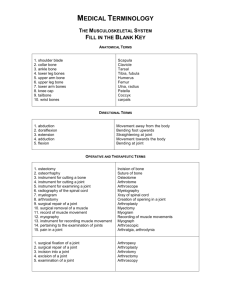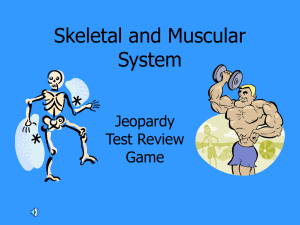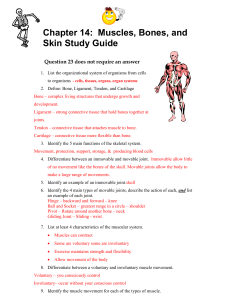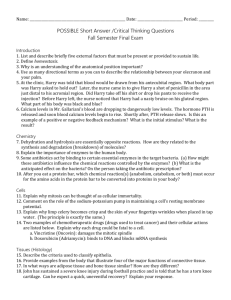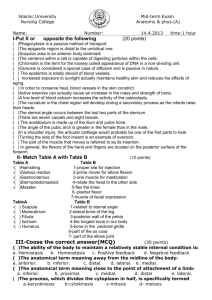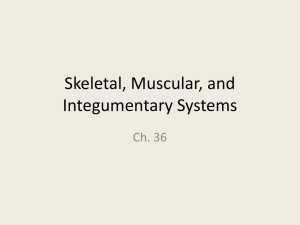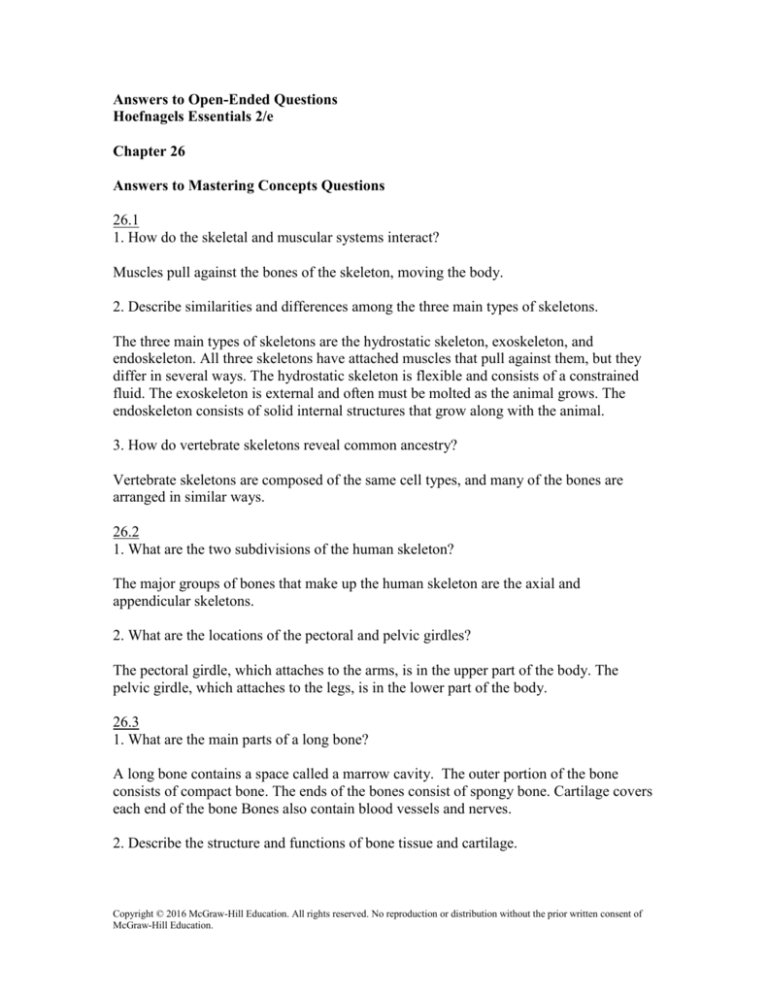
Answers to Open-Ended Questions
Hoefnagels Essentials 2/e
Chapter 26
Answers to Mastering Concepts Questions
26.1
1. How do the skeletal and muscular systems interact?
Muscles pull against the bones of the skeleton, moving the body.
2. Describe similarities and differences among the three main types of skeletons.
The three main types of skeletons are the hydrostatic skeleton, exoskeleton, and
endoskeleton. All three skeletons have attached muscles that pull against them, but they
differ in several ways. The hydrostatic skeleton is flexible and consists of a constrained
fluid. The exoskeleton is external and often must be molted as the animal grows. The
endoskeleton consists of solid internal structures that grow along with the animal.
3. How do vertebrate skeletons reveal common ancestry?
Vertebrate skeletons are composed of the same cell types, and many of the bones are
arranged in similar ways.
26.2
1. What are the two subdivisions of the human skeleton?
The major groups of bones that make up the human skeleton are the axial and
appendicular skeletons.
2. What are the locations of the pectoral and pelvic girdles?
The pectoral girdle, which attaches to the arms, is in the upper part of the body. The
pelvic girdle, which attaches to the legs, is in the lower part of the body.
26.3
1. What are the main parts of a long bone?
A long bone contains a space called a marrow cavity. The outer portion of the bone
consists of compact bone. The ends of the bones consist of spongy bone. Cartilage covers
each end of the bone Bones also contain blood vessels and nerves.
2. Describe the structure and functions of bone tissue and cartilage.
Copyright © 2016 McGraw-Hill Education. All rights reserved. No reproduction or distribution without the prior written consent of
McGraw-Hill Education.
Bone and cartilage are both connective tissues with cells embedded in a solid matrix. A
cross section of bone tissue reveals a central canal surrounded by concentric rings of bone
cells and mineral/collagen matrix. The minerals make the bone hard, and the collagen
adds flexibility, elasticity, and strength. In cartilage, the rubbery matrix consists of
collagen, other protein fibers, and water. The proteins give cartilage resilience, strength,
and elasticity, and the water makes it a good shock absorber.
3. What are the relationships among joints, tendons, and ligaments?
A joint is a location where two bones meet. A ligament consists of connective tissue that
holds the bones together in a joint. A tendon consists of connective tissue that connects a
muscle to a bone.
4. How are bones remodeled and repaired throughout life?
In an embryo and early fetus, bones consist of cartilage. Before birth, however, boneforming cells enter the cartilaginous matrix and begin to secrete the bony matrix. As the
child grows, the replacement of cartilage by bone occurs at growth plates at the ends of
bones. A person’s bones are fully grown by the early 20s. The bones become thicker and
denser through heavy exercise and, conversely, become lighter and less dense from lack
of exercise. Throughout life, specialized bone cells break down bone tissue if blood
calcium concentrations dip too low. In addition, if a bone is broken, bone cells near the
site repair the break.
5. How do bones participate in calcium homeostasis?
Hormones from the parathyroid and thyroid glands stimulate bones to release calcium
when blood levels are too low or absorb calcium from blood when blood contains excess
calcium.
26.4
1. What is an antagonistic pair of muscles?
An antagonistic pair of muscles moves a bone in a back-and-forth motion. Contraction of
one muscle pulls a bone in one direction; contraction of the second muscle pulls the bone
in the opposite direction.
2. Describe the levels of organization of a muscle.
Moving from the largest structure to the smallest, a muscle is an organ consisting of
several tissue types, including muscle tissue. Muscle tissue consists of parallel bundles
of cells called muscle fibers. Each muscle fiber contains hundreds of myofibrils, which
are in turn made of many actin and myosin protein filaments.
3. Describe how sliding filaments shorten a sarcomere.
Copyright © 2016 McGraw-Hill Education. All rights reserved. No reproduction or distribution without the prior written consent of
McGraw-Hill Education.
A sarcomere consists of thick myosin filaments and thin actin filaments that can slide
past one another. As a muscle contracts, the pivoting head of a myosin filament swings
out and connects with actin to form a cross bridge. When the myosin head bends, the thin
filament then slides between the thick filaments, shortening the sarcomere.
4. How do ATP, motor neurons, and calcium ions participate in muscle contraction?
A motor neuron’s axon releases the neurotransmitters that trigger an electrical signal in a
muscle cell. The electrical signal stimulates calcium ions to pour out of the muscle cell’s
endoplasmic reticulum. Calcium slightly changes the shape of the muscle cell’s thin actin
filaments, allowing myosin heads to bind to (and pull on) the actin subunits. ATP
provides the energy for muscle contraction by binding to the myosin cross bridges,
changing their shape in a way that allows them to prepare for the next “pull” on the actin
filaments.
5. How can the same muscle generate both small and large movements?
The same muscle can generate both small and large movements, depending on how many
of its motor units are engaged. Few motor units are required for small motions; more are
required for large motions.
26.5
1. Describe the role of creatine phosphate in muscle metabolism.
A muscle cell’s supply of ATP is quickly exhausted, but creatine phosphate donates a
high-energy phosphate to ADP to quickly regenerate ATP.
2. What happens when a muscle cell cannot generate ATP by aerobic respiration?
Muscle cells switch to fermentation when they cannot generate ATP by aerobic
respiration.
26.6
1. Why do endurance sports require a high proportion of slow-twitch muscle fibers,
whereas power sports require more fast-twitch muscle fibers?
Slow- and fast-twitch muscles differ in their size and endurance. Slow-twitch muscles
(“red meat”) are smaller and have ample supplies of oxygen to support aerobic
respiration, which is required for high-endurance activities. Fast-twitch muscles (“white
meat”) are larger and lack a rich blood supply, so they rely on anaerobic metabolic
pathways to fuel short, powerful contractions with low endurance.
2. How does exercise strengthen muscles?
Copyright © 2016 McGraw-Hill Education. All rights reserved. No reproduction or distribution without the prior written consent of
McGraw-Hill Education.
Exercise causes muscle cells to grow larger; increases the concentration of active
enzymes and the abundance of mitochondria in muscle cells; and increases the blood
supply to muscles.
Write It Out
1. Distinguish among a hydrostatic skeleton, an exoskeleton, and an endoskeleton. What
are the advantages and disadvantages of each type of skeleton? Give an example of an
animal with each type.
A hydrostatic skeleton (hydro- means water) consists of fluid constrained within a layer
of flexible tissue. This is the simplest type of skeleton, but because it does not consist of
hard parts, it does not protect the animal’s body. An example of an animal with a
hydrostatic skeleton is a jellyfish. An exoskeleton (exo- means outside) is hard and
protects an animal from the outside, much like a suit of armor. Molting, however, leaves
the animal vulnerable until it produces a new exoskeleton; moreover, exoskeletons are
too heavy for large animals. A beetle has an exoskeleton. An endoskeleton (endo- means
inner) is an internal support structure. Its chief advantage is that it can grow with the
animal, but it does not protect the animal’s surface. Humans have endoskeletons.
2. Explain the observation that animals with exoskeletons and endoskeletons are better
represented in the fossil record than are animals with hydrostatic skeletons. How might
this difference affect scientific interpretations of the fossil record?
Hard body parts fossilize more easily, and therefore aquatic animals with hydrostatic
skeletons are underrepresented in the fossil record. This can lead to several incorrect
interpretations of the record: that there were fewer soft-bodied animals, that soft-bodied
animals were less important in the evolutionary history of life, or that hard-bodied
organisms evolved quite suddenly.
3. Use the Internet to research bone marrow transplants. What do patients who receive
these transplants have in common?
In a bone marrow transplant, healthy bone marrow is used to replace abnormal or
damaged bone marrow that does not produce normal blood cells. The healthy marrow can
come from a patient’s own body (for example, before treatment for cancer) or from a
donor. Bone marrow transplants are risky procedures reserved for patients with diseases
affecting the blood, such as leukemia or multiple myeloma.
4. What are the differences between spongy bone and compact bone?
Compact bone and spongy bone differ in density. Compact bone is dense and consists of
closely packed, microscopic cylinders of bone tissue. Blood vessels occupy central canals
in these cylinders. Spongy bone is hard, but it has many large spaces in a web of bony
struts, which makes it lighter. Red marrow, a nursery for blood cells and platelets, fills
these spaces in spongy bone.
Copyright © 2016 McGraw-Hill Education. All rights reserved. No reproduction or distribution without the prior written consent of
McGraw-Hill Education.
5. Design an experiment to test whether changes in the atmosphere (such as an incoming
thunderstorm) cause joint pain. Then, use the Internet to learn whether researchers have
found evidence to support a connection between weather and joint pain.
[Answers will vary; this is one possible answer.] The experiment could have two groups,
one that experiences laboratory conditions that simulate changing weather (the test
group) and another that does not experience changing conditions (the control group). The
test group will be used to determine if changing conditions are correlated with joint pain.
The control group will reveal how often people feel joint pain when no weather changes
are occurring. In medical studies, little evidence supports the relationship between joint
pain and changes in the weather.
6. Suppose a young boy severely fractures his femur. Describe how the injury could
affect his growth.
If the fracture is in the middle of the shaft of his femur, then bone cells near the site of the
injury will produce new bone tissue. The bone therefore repairs itself. Meanwhile, the
bone continues to elongate at the growth plate, so his growth should be unaffected.
However, a fracture through the growth plate could slow down bone growth as the site of
injury is repaired. If during repair the cartilage in the growth plate is replaced with bone
tissue, then bone growth may permanently slow down.
7. Bones typically become stronger with exercise. However, some athletes develop stress
fractures from overexercising. Why might light exercise strengthen bones but intense
exercise cause fractures?
Exercise typically puts moderate stress on bones, and damaged bone cells are constantly
degraded and replaced with new cells. Light exercise a few times a week therefore keeps
bones strong. However, rigorous exercise every day might damage more cells than the
bone can replace, slowly weakening the bone. Eventually the weak bone may develop a
small crack called a stress fracture.
8. How can an imbalance in calcium homeostasis lead to osteoporosis?
When blood calcium levels are low, calcium is not deposited in bone. The lack of
calcium in bone leads to osteoporosis.
9. How do antagonistic muscle pairs move bones? Give an example of such a pair.
A contracting muscle can pull a bone in only one direction; it cannot push the bone the
opposite way. The body can generate back-and-forth movements because many skeletal
muscles occur in antagonistic pairs whose members operate in opposite directions. For
example, when a person contracts the biceps, the arm bends at the elbow joint.
Contraction of the triceps muscle straightens the arm.
Copyright © 2016 McGraw-Hill Education. All rights reserved. No reproduction or distribution without the prior written consent of
McGraw-Hill Education.
10. Write the sequence of events that leads to a muscle contraction, starting with “An
action potential travels along the axon of a motor neuron.”
An action potential travels along the axon of a motor neuron. The action potential reaches
the end of the axon, and neurotransmitters are released into the synapse. The
neurotransmitters bind to receptor proteins on the muscle fiber. Upon receiving the signal
from the motor neuron, electrical waves spread along the muscle cell membrane, causing
the endoplasmic reticulum to release calcium ions. Calcium slightly changes the shape of
the thin filament, allowing myosin to bind. After binding, the myosin head bends, causing
the actin filament to slide past the myosin filament. An ATP molecule binds to the
myosin head, causing actin and myosin to separate. The ATP then splits, releasing energy
that returns the myosin head to its original position. If calcium is still present, then a new
cross bridge forms.
11. How might your muscles lengthen when you stretch? Use sarcomere, myosin, actin,
and tendon in your answer.
As you stretch, myosin and actin filaments slide alongside one another, allowing a
sarcomere in a relaxed muscle to lengthen. As all sarcomeres lengthen, the muscle
becomes longer. As the muscle reaches its full length, the tendons that connect the
muscle to a bone may also slightly lengthen.
12. How do the effects of exercise (or lack thereof) illustrate homeostasis in bones and
muscles?
Less-used bones lose mass as bone minerals slowly dissolve. For example, astronauts
lose bone density if they are in a prolonged weightless environment because their
musculoskeletal systems don’t have to work as hard as they do against Earth’s gravity.
Likewise, a muscle exercised regularly increases in size because each muscle cell
thickens. An unused muscle shrinks.
13. How does the muscular system interact with the nervous system? The skeletal
system? The respiratory system? The circulatory system?
The muscular system requires neurotransmitters from the nervous system to provide the
signal to contract. The muscles of the muscular system attach to the bones of the skeletal
system. The respiratory system brings in the O2 that muscles need for aerobic respiration,
and the circulatory system delivers it via the capillaries.
14. Search the Internet for disorders of the skeletal or muscular system. Choose one such
illness to research in more detail. Describe how the disorder interferes with bone or
muscle function. What causes the disorder? Is a treatment or cure available?
Possible disorders include, but are not limited to: rheumatoid arthritis, osteoporosis,
carpal tunnel system, fibromyalgia, and Duchenne muscular dystrophy. For example, in
rheumatoid arthritis, the immune system attacks the tissues of the movable joints. The
Copyright © 2016 McGraw-Hill Education. All rights reserved. No reproduction or distribution without the prior written consent of
McGraw-Hill Education.
cartilage covering the ends of the bones can become inflamed or even be destroyed. This
causes severe pain and, sometimes, even deformities in the joints as the joint surfaces no
longer move smoothly and easily. Although there is no known cure for rheumatoid
arthritis, it can be treated with pain relievers, anti-inflammatory drugs, rest, and joint
strengthening exercises.
15. What is the role of calcium in bones? In muscle contraction?
Calcium hardens the matrix of the bones, which help regulate calcium homeostasis. In
muscle contraction, stimulation by a motor neuron triggers the release of calcium ions
from the muscle cell’s endoplasmic reticulum. These calcium ions indirectly enable actin
and myosin filaments to bind. As a result, the muscle can contract.
16. The following table shows recent men’s world-record times for various running
events. Graph the distance traveled against the average running speed. How does the
production of ATP by muscles over time explain the graph?
Muscle contraction requires ATP. In the short races (100 and 200 m), which last less than
20 seconds, creatine phosphate quickly replenishes ATP. Longer races require a steady
supply of O2 to support aerobic respiration, which generates ATP as long the lungs and
blood can deliver sufficient O2. Once the demand for O2 exceeds the supply, as in a long
race, the muscles will switch to fermentation to generate ATP. Fermentation does not
require O2 but generates ATP less efficiently than aerobic respiration.
Pull It Together
1. How do bones help maintain blood calcium concentrations?
Bones serve as a reservoir for calcium, releasing calcium when the blood concentration is
too low and absorbing calcium when the blood concentration is too high.
2. Connect exercise to the concept map in at least three different places.
“Exercise” leads with “strengthens” to “Bones” and to “Skeletal muscles.” “Exercise”
leads with “promotes growth of” to “Muscle fibers”. “Exercise” leads with “requires
coordinated action potentials in” to “Motor neurons.” “Exercise” leads with “requires
contraction of muscles via interactions between” to “Actin” and “Myosin.”
3. Add neurotransmitters and ATP to this concept map.
"Neurotransmitters" connects with the phrase "are released by" to "Motor neurons."
"ATP" connects with the phrase "is required for the contraction of" to "Muscle fibers."
4. Add fast- and slow-twitch muscle fibers to this concept map. How do these two cell
types differ?
Copyright © 2016 McGraw-Hill Education. All rights reserved. No reproduction or distribution without the prior written consent of
McGraw-Hill Education.
“Muscle fibers” connects with “that use energy quickly and have low endurance are
called” to “Fast-twitch muscle fibers.” “Muscle fibers” connects with “that use energy
slowly and have high endurance are called” to “Slow-twitch muscle fibers.”
Slow-twitch muscle fibers have smaller diameters. They use ATP slowly and regenerate
it using aerobic respiration. Fast-twitch muscle fibers have larger diameters and generate
stronger contractions. They burn ATP quickly; they also have fewer capillaries and store
less oxygen than slow-twitch muscle fibers.
Copyright © 2016 McGraw-Hill Education. All rights reserved. No reproduction or distribution without the prior written consent of
McGraw-Hill Education.



